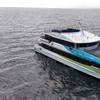Coast Guard Commandant Optimistic About Icebreaker Funding
The United States may soon get funding for a new heavy icebreaker ship, the head of the U.S. Coast Guard said on Thursday, as global warming spurs the race to stake out the Arctic, which is rich in oil, gas, and minerals.
The United States has two operational icebreakers - a heavy one, the Polar Star, which is more than 42 years old and has outlived its life expectancy by a dozen years, and a medium one, the Healy cutter.
By comparison, Russia has about 40 to 50 icebreakers, purpose-built vessels that can rescue other ships, supply bases, and reach oil spills in harsh polar conditions.
"I'm guardedly optimistic funding for that first polar security cutter is going to be there," Commandant Karl Schultz said at a National Press Club event.
Icebreakers support scientific missions and operate in the Arctic and Antarctic, which hold vast natural gas, oil, mineral, fish, and fresh water resources, Schultz said.
While Washington participates in several forums on Arctic security and cooperation, such as the Arctic Council, it also needs to ensure it has the necessary equipment, he said. China early this year declared itself a "Near Arctic State," outlined how it believed the region should be developed, and is expanding its icebreaker fleet.
"Diplomacy and cooperation are really hollow or shallow without presence," Schultz said, adding that the country needs a minimum of six icebreakers, which can cost about $1 billion each and take up to 10 years to build. "If we're not present, if we don't own the environment today, guess who owns it tomorrow - our competitors."
While President Donald Trump's administration has budgeted $750 million for an icebreaker, it is not certain whether the funding will survive in Congress, which is also looking for ways to fund the border wall with Mexico, among other items.
The Coast Guard is part of Homeland Security, one of several departments that have not been funded for the 2019 budget. Congress is expected to consider a $450 billion bill, before stopgap funding expires on Dec. 21, to fund the agencies through the fiscal year that ends next Sept. 30.
Reporting by Timothy Gardner














